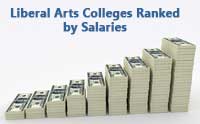 Evaluating Liberal Arts Colleges by how much graduates make is antithetical to the concept of a liberal arts education in so many ways. But given the fact that 100 Liberal Arts Colleges now cost more than $50,000, I don’t care how much aid the students are receiving, families have every right to know what kind of pay-off the student can expect. This doesn’t mean that families don’t appreciate the value of a liberal arts education. It’s just recognition that there will bills and loans to repay after graduation.
Evaluating Liberal Arts Colleges by how much graduates make is antithetical to the concept of a liberal arts education in so many ways. But given the fact that 100 Liberal Arts Colleges now cost more than $50,000, I don’t care how much aid the students are receiving, families have every right to know what kind of pay-off the student can expect. This doesn’t mean that families don’t appreciate the value of a liberal arts education. It’s just recognition that there will bills and loans to repay after graduation.
General
How Much Do Colleges Spend on D2 Baseball Programs?
 As is the case for most sports, Division 2 is the smallest for baseball in the NCAA. According to the Office of Postsecondary Education, in 2013 there were 260 D2 baseball programs in 43 states including Puerto Rico. Pennsylvania had the most with 20, followed by California with 16. Georgia, Missouri, North Carolina, New York tied for third with 14 programs each.
As is the case for most sports, Division 2 is the smallest for baseball in the NCAA. According to the Office of Postsecondary Education, in 2013 there were 260 D2 baseball programs in 43 states including Puerto Rico. Pennsylvania had the most with 20, followed by California with 16. Georgia, Missouri, North Carolina, New York tied for third with 14 programs each.
What The Coalition for Access, Affordability, and Success Really Means
 Last September a group of 80 colleges announced a new college application designed to improve access, affordability, and success. They actually call themselves the Coalition for Access, Affordability, and Success. But for some reason, the counselors who work with high school students, both private and school-based, don’t seem impressed with the new option. Maybe because the Coalition apparently hasn’t even piloted the application yet or listed any committed Community Based Organizations?
Last September a group of 80 colleges announced a new college application designed to improve access, affordability, and success. They actually call themselves the Coalition for Access, Affordability, and Success. But for some reason, the counselors who work with high school students, both private and school-based, don’t seem impressed with the new option. Maybe because the Coalition apparently hasn’t even piloted the application yet or listed any committed Community Based Organizations?
50-50 Highlights: Colleges in the Economist’s Top 100 College Rankings
 During last fall’s college rankings frenzy, I missed the Economist’s first ever contribution to the college rankings. Having taken some time to look over the list and methodology, I think they have something meaningful to contribute to comparing colleges. Like Money Magazine’s Rankings, the Economist is looking at the financial results of a college education. Unlike Money which focuses on the Return On Investment, the Economist’s college rankings are focused on the school effect.
During last fall’s college rankings frenzy, I missed the Economist’s first ever contribution to the college rankings. Having taken some time to look over the list and methodology, I think they have something meaningful to contribute to comparing colleges. Like Money Magazine’s Rankings, the Economist is looking at the financial results of a college education. Unlike Money which focuses on the Return On Investment, the Economist’s college rankings are focused on the school effect.
Are College Baseball Players Happy?
 (The data is from 2010 but I think is still valuable today.)
(The data is from 2010 but I think is still valuable today.)
Do you know what you’re in for if you end up playing college baseball? Sure, you’ve talked to the coach multiple times and have done your overnight with the player. And you probably know about being able to do three things in college, study, play ball, and party but athletes only get to pick two. But do you really think you know what it’s going to be like?
What’s Important to College Baseball Coaches
 So why is a college baseball coach more likely to lose interest in a high school prospect, showing poor attitude at a game where the coach is watching or a poor high school season? If you said poor high school season, you’re wrong. Which would have a greater negative effect on the recruiting coach, seeing a game where the player had a poor performance or low grades? Obviously poor performance, right? Wrong. It’s low grades.
So why is a college baseball coach more likely to lose interest in a high school prospect, showing poor attitude at a game where the coach is watching or a poor high school season? If you said poor high school season, you’re wrong. Which would have a greater negative effect on the recruiting coach, seeing a game where the player had a poor performance or low grades? Obviously poor performance, right? Wrong. It’s low grades.
50-50 Highlights: Doctoral/Research Universities Ranked by Students’ Salaries
 This fall’s college rankings have made earnings and return on investment a more prominent consideration when selecting a college. And with the ever increasing cost of college, this is a very reasonable reaction. However, ranking colleges by some form of graduates’ salaries has its own set of problems. Teachers simply don’t make as much as engineers or investment bankers but we need teachers. Incomes are higher in areas with higher costs of living. And these are just some of the obvious issues of ranking universities by graduates’ salaries. But this shouldn’t stop you from using the available information–just understand its limitations.
This fall’s college rankings have made earnings and return on investment a more prominent consideration when selecting a college. And with the ever increasing cost of college, this is a very reasonable reaction. However, ranking colleges by some form of graduates’ salaries has its own set of problems. Teachers simply don’t make as much as engineers or investment bankers but we need teachers. Incomes are higher in areas with higher costs of living. And these are just some of the obvious issues of ranking universities by graduates’ salaries. But this shouldn’t stop you from using the available information–just understand its limitations.
What You Need to Know About the DIY College Rankings College Profile
 In each of my newsletters, I include a brief profile of a 50-50 college. For those new to my website, a 50-50 school is a college that accepts at least 49% of students and has at least a 49% graduation rate. I use the four-year rate for private schools and the five-year rate for public. You can download a complete list here.
In each of my newsletters, I include a brief profile of a 50-50 college. For those new to my website, a 50-50 school is a college that accepts at least 49% of students and has at least a 49% graduation rate. I use the four-year rate for private schools and the five-year rate for public. You can download a complete list here.
I have also created profiles for over 350 of them so far and am gradually getting them all listed. You can find individual profiles here. With all of the college search websites available, it wouldn’t be unreasonable for you to wonder why I bother, or more importantly, why you should bother to look at them.
How to Pay Less for College: Avoid Goldilocks Colleges
 I started off this series of How to Pay Less for College by discussing how the economics of supply and demand are the basis for cutting the cost of college. The next two posts on college rankings and geography were basically explaining two significant elements that affect how much families will pay for college. Today I want to talk about a third factor that falls under the supply and demand of college admissions: college size.
I started off this series of How to Pay Less for College by discussing how the economics of supply and demand are the basis for cutting the cost of college. The next two posts on college rankings and geography were basically explaining two significant elements that affect how much families will pay for college. Today I want to talk about a third factor that falls under the supply and demand of college admissions: college size.


